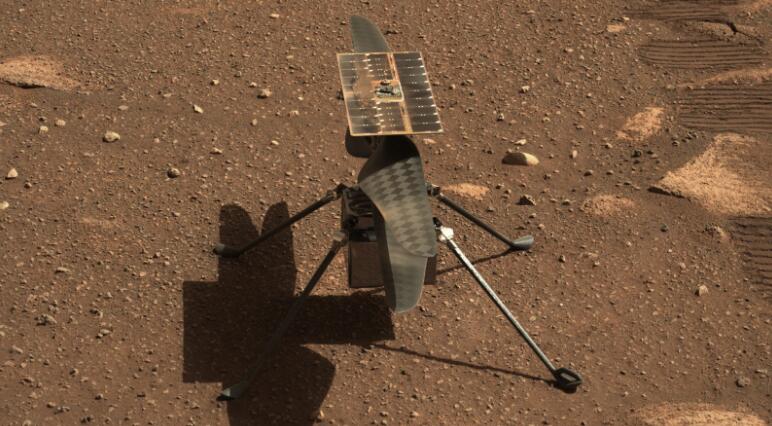The NASA wit Mars helicopter has successfully taken off on the surface of Mars, hovering at an altitude of about 3 meters above the ground for 30 seconds, and then returned to the ground. This is the first time that humans have conducted a powered flight on another planet, and it is also a human space exploration. A milestone.
Although many human spacecraft have reached the sky of another planet, most of them have landed on the surface from space or made orbital flights on the planet’s satellite orbits. This is not the same as maintaining a helicopter flying in a planetary environment. Different concepts.
It took 6 years to build the Gwit Mars helicopter. The seemingly simple mission is actually very complicated!
Why is it difficult to fly to Mars?
When flying a helicopter on another planet, the biggest challenge is to allow the helicopter to fly in a completely different environment from that of the earth. The helicopter’s rotor needs to adapt to the atmospheric environment and generate enough ascent. Different planets also have different gravitational effects.
Although Mars has an atmosphere, the atmosphere of Mars is only 1% of the density of the earth’s atmosphere. A helicopter flying on Mars is equivalent to a terrestrial helicopter flying at an altitude of 30 kilometers, while the current altitude of commercial aircraft on Earth is maintained at 12 kilometers. Within the altitude, the maximum altitude of the helicopter flight is only about 13 kilometers.
The Martian atmosphere is very unfriendly to helicopters, but then we need to consider the gravity of Mars.
Although Mars is a neighbor of the earth, it has completely different characteristics from the earth. The gravity of Mars is only 37% of that of the earth. This means that the helicopter only needs to generate a small amount of ascent force to overcome the influence of Mars’ gravity.
If the atmosphere of Mars is exactly the same as that of the earth, then helicopter take-off will become extremely easy. Unfortunately, although the ascending force required by the Martian helicopter is reduced, the thin atmosphere of Mars makes it extremely difficult to generate every piece of ascending force. In general, although the gravity of Mars is beneficial to helicopters, the lack of atmospheric density on Mars is even more serious.
In order to ensure that the Giz Mars helicopter can perform normal missions on Mars, the research team built a closed chamber on the earth to extract air from the chamber to simulate the atmospheric environment of Mars, thereby testing how much the helicopter can generate ascent under Martian atmospheric conditions force.
According to the experimental environment, if the helicopter can fly in a chamber that simulates the atmosphere of Mars, then the helicopter can definitely fly on Mars. Therefore, the gravity of the earth is much greater than that of Mars, and the helicopter needs to generate about 3 times ascending force to overcome the earth. Gravity completes the flight.
This process is extremely difficult, because the largest power source of a helicopter is the rotor. If you want to fly in the Martian environment, the rotation speed of the rotor is much greater than that of an ordinary helicopter. This means that more energy is needed. In space operations, The most lacking is energy. If the Mars helicopter needs to carry cameras or other scientific instruments in the future, the overall energy consumption will increase. In order to solve the contradiction, the Mars helicopter must be very light and the power of the helicopter rotor needs to be greatly increased.
What kind of “upgrades” has the Mars helicopter been developed for 6 years?
The most direct way to generate enough lift on Mars is to accelerate the helicopter’s rotor.
Wit is equipped with two rotors, both made of carbon fiber, which are lightweight and durable. Unmanned helicopters on the earth only need about 500 revolutions per minute to generate enough ascent force, while the wit’s rotor can reach more than 2,400 revolutions per minute, which even exceeds the rotor speed of a manned commercial helicopter, but simply increases The rotation speed of the rotor does not completely solve the problem of the Martian helicopter, and the load needs to be reduced.
The weight of the entire wit Mars helicopter is only about 2 kilograms, and the design of wit is also very peculiar. Its body is only the size of a tissue box, but its rotor is 1.2 meters long. The larger rotor, faster rotor speed, and lighter body allow Witt to generate enough ascent in the Martian environment to watch Mars from the sky.
Giz has completed flight tests at 3 meters. In the next few weeks, Giz will continue to perform 3-4 flights, including a 5 meter flight test and a 300-meter long-distance flight test. Giz will Collect the necessary data from these tests to provide experience for the follow-up Mars helicopter.
At present, the Mars helicopter data needs to be transmitted to Perseverance first, and then passed to the satellite by Perseverance, before finally reaching the earth. The whole process takes about several hours. Even if the most direct data transmission is used, there will be a delay of about 20 minutes. Therefore, at present, humans cannot control the Martian helicopter in real time. During the flight, the Martian helicopter has a very large “autonomy.”
It is expected that humans will land on Mars for the first time in 2035. The research team hopes that Mars helicopters can act as “scouts.” By manipulating unmanned helicopters on Mars, real-time control can be achieved, just like terrestrial drones, helping astronauts observe the distance ahead The ground conditions, avoid obstacles or dangerous terrain, and even look for water sources and other life.
At present, Earth drones can even help deliver fast. The Mars research team also hopes that future Mars helicopters can help astronauts transport items. If astronauts lose tools outside the base or need supplies, Mars unmanned helicopters may be able to transport food or Toolbox, making Mars exploration work more convenient!






